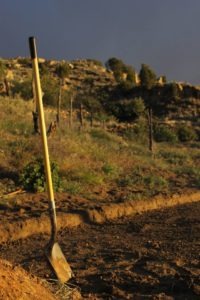 A red-tailed hawk soared above us, it’s screech echoing across the valley and off the mesa before us. As we tilled the field with mattock, rake and hoe, I couldn’t help but feel the energy of this ancient land in the air.
A red-tailed hawk soared above us, it’s screech echoing across the valley and off the mesa before us. As we tilled the field with mattock, rake and hoe, I couldn’t help but feel the energy of this ancient land in the air.
I woke up this morning damp in a soggy down sleeping bag. It had rained and poured whilst I tried to snore all night. I find the pitter patter of raindrops on a tent to be soothing and peaceful, but admittedly I was a little grouchy waking up wet.
Morning came; I crawled out of the tent to our perpetually burning fire. As I ate my blueberry cereal and hot milk, Dorothy, our Hopi host explained how special the rain is for the Hopi, and how it was a great day to plant corn. The Hopi believe this is the fourth world, when they emerged here, Masau told them that when looking for a home they would encounter lush landscapes rich with water and game, but not to be tempted by these, and to move on. He told them of a harsh environment in the desolate desert… a place where no one else would be able to flourish in, or desire to live. This place would require a lot of hard work, but would be home for the Hopi. He gave them corn and a planting stick.
A main factor that makes living here so tough is the lack of rain. Traditionally, the Hopi don’t use irrigation, so this rain was very important. I started to embrace it. Dorothy sent all of us males down to the field armed with rakes, hoes, and mattocks. Our task was to till and clear it of all Russian thistle and other plants that had taken over after the fall harvest. About the time we got down to the field, the rain let up and some blue sky peaked through grey clouds. We got to work and quickly warmed off the morning chills.
After a couple days of being cooped up in the van driving, we itched to use our bodies. We came in hot, eager to move dirt and work the field using human power. While swinging the mattock, I thought about who may have been stepping on this same soil thousands of years ago. Dorothy’s farm has one of the only springs for miles that leaks fresh water all day and night, a rich piece of land.
Evidence of past Hopi was abundant. Just about everywhere I stepped were pottery shards. This whole time, a red-tailed hawk was circling overhead. Letting out an occasional cry that cut through the stillness of the air. The hawk made its rounds and then returned to its perch on a nearby old and weathered cottonwood tree, keeping an eye on us below in the field. Once in a while, the hawk’s partner joined in, the two of them soaring around us… supervising.
While this was happening, the women of our group, led by Dorothy, were up at our camp separating corn kernel from cob. When the cobs were bare, they met us at the field, helped finish tilling, and it was time to plant.
We lined up, five men, three to four paces apart, mattock in hand. Behind us, five women each with a bowl of corn kernels, white corn to be specific. In Hopi culture, white corn is used in the birth ceremony. It’s in the first meal that babies eat when they’re born.
Dorothy told us to dig down until the soil became moist. The Hopi practice dry-land farming with no irrigation, so it is essential to plant deep enough.
I heaved the mattock over my shoulder and made a hole, took three steps and made another… repeat, repeat, repeat. The women followed behind, planting at least 12 kernels in each hole. Why so many? The Hopi believe that some corn will go to the sun, some the wind, and some the rain or snow. Some corn will go to the squirrels and other animals, while some will stay in the earth. Any remaining corn will go to the people. I believe this is the Hopi way of reckoning with and respecting the natural ecosystem.
And so we planted corn the Hopi way, some sand songs to pass on good energy, the hawk looked on. Right when we finished, dark clouds rolled in and unleashed, pouring rain out to bless the seeds with moisture, just in time. Walking back to our camp, raindrops splashed off my face, and I felt the magic of what we just experienced. It was as if the earth had planned for us to plant corn at that exact time. A lesson to learn from the Hopi: respect the earth, and the earth will respect you.